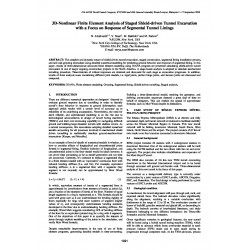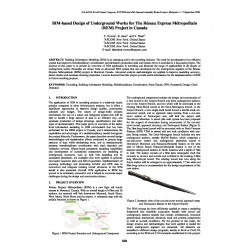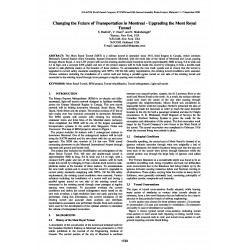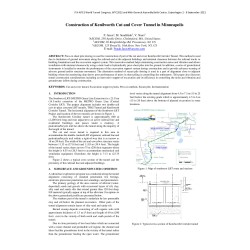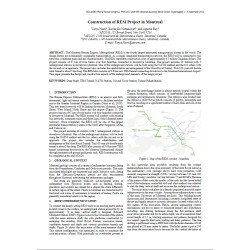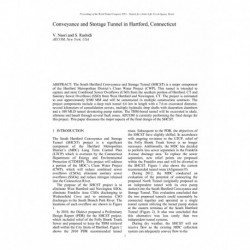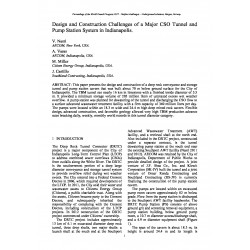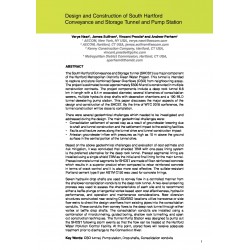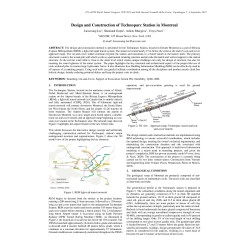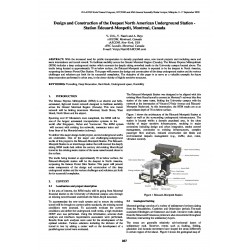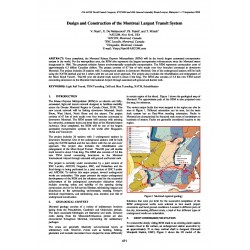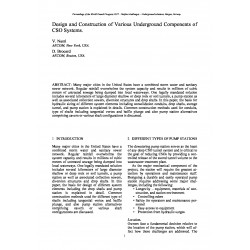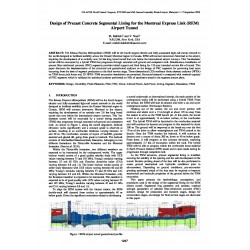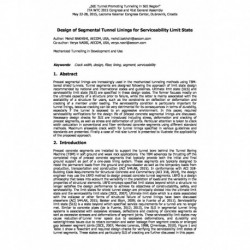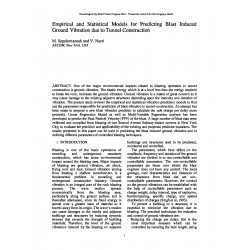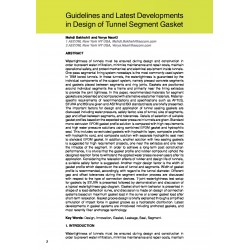No document
Search & filter
Search for a publication
Search & filter
List of products by author: V. Nasri
- 1
- 2
-
3D-Nonlinear Finite Element Analysis of Staged Shield-driven Tunnel Excavation with a Focus on Response of Segmental...
Abstract: The complex and dynamic nature of shield-driven tunnel excavation, staged construction, segmental lining installation process, and tail-void grouting necessitate using detailed numerical modeling for predicting ground behavior and response of segmental lining. In this paper, results of three-dimensional advanced finite element modeling using DIANA program are presented simulating shield-driven...
0,00 € -
BIM-Based Design of Underground Works for the Réseau Express Métropolitain (REM) Project in Canada
Abstract: Building Information Modeling (BIM) is an emerging tool in the tunneling industry. The need for development of an efficient system that improves interdisciplinary coordination and minimizes production time and human errors is essential in a fast-paced project. The purpose of this paper is to present an overview of BIM application in tunneling and illustrate the range of applicability in all...
0,00 € -
Changing the Future of Transportation in Montreal - Upgrading the Mont Royal Tunnel
Abstract: The Mont Royal Tunnel (MRT) is a railway tunnel in operation since 1918, third longest in Canada, which connects Montreal's Central Station (Gare Centrale), located Downtown Montreal, with the north side of the Island of Montreal and Laval, passing through Mount Royal. A new LRT project will use this existing double-track horseshoe tunnel (approximately 5060 m long, 9.6 m wide and 4.4 m high,...
0,00 € -
Construction of Kenilworth Cut and Cover Tunnel in Minneapolis
Abstract: Press-in sheet pile shoring is used for construction of part of the cut and cover Kenilworth Corridor Tunnel. This method is used due to limitation of ground movement along the railroad and at the adjacent buildings and minimal clearance between the railroad tracks or building foundations and the excavation support system. This innovative method helps minimizing construction noise and vibration...
0,00 € -
Construction of REM Project in Montreal
Abstract: The Montreal Réseau Express Métropolitain (REM) is the fourth largest automated transportation system in the world. The design fosters environmentally sustainable transportation. As a single, integrated transportation network, the REM will be connected to bus networks, commuter trains and the Montréal metro. The REM represents construction costs of approximately 6.3 billion Canadian dollars....
0,00 € -
Conveyance and Storage Tunnel in Hartford, Connecticut
Abstract: The South Hartford Conveyance and Storage Tunnel (SHCST) is a major component of the Hartford Metropolitan District’s Clean Water Project (CWP). This tunnel is intended to capture and store Combined Sewer Overflows (CSO) from the southern portion of Hartford, CT and Sanitary Sewer Overflows (SSO) from West Hartford and Newington, CT. The project is estimated to cost approximately $500 MM and...
0,00 € -
Design and Construction Challenges of a Major CSO Tunnel and Pump Station System in Indianapolis
Abstract: This paper presents the design and construction of a deep rock conveyance and storage tunnel and pump station cavern that was built about 70 m below ground surface for the City of Indianapolis. The TBM tunnel ran nearly 16 km in limestone with a finished inside diameter of 5.5 m. It provided a minimum storage volume of 205 million liters of untreated excess wet weather overflow. A pump station...
0,00 € -
Design and Construction of South Hartford Conveyance and Storage Tunnel and Pump Station
Abstract: The South Hartford Conveyance and Storage Tunnel (SHCST) is a major component of the Hartford Metropolitan District’s Clean Water Project. This tunnel is intended to capture and store Combined Sewer Overflows (CSO) from neighbouring areas. The project is estimated to cost approximately $500 M and is constructed in multiple construction contracts. The project components include a deep rock...
0,00 € -
Design and Construction of Technoparc Station in Montreal
Abstract: The design and construction method is presented for the Technoparc Station, located in Greater Montreal as a part of Réseau Express Métropolitain (REM), a light rail rapid transit system. The station is located nearly 15 m below the street at the end of a cut-and-cover approach ramp. The cut-and-cover tunnel continues beyond the station and transitions to a bored tunnel at the launch shaft. The...
0,00 € -
Design and Construction of the Deepest North American Underground Station - Station Edouard Monpetit, Montreal, Canada
Abstract: With the increased need for public transportation in densely populated areas, new transit projects start including more and more interstations and tunnel rework. To facilitate mobility across the Greater Montreal Region (Canada), The Réseau Express Métropolitain (REM) includes a deep underground station which connects the deeply sitting reworked tracks to the University campus located above....
0,00 € -
Design and Construction of the Montreal Largest Transit System
Abstract: Once completed, the Montreal Réseau Express Métropolitain (REM) will be the fourth largest automated transportation system in the world. For the metropolitan area, the REM also represents the largest transportation infrastructure since the Montreal metro inaugurated in 1966. The proposed solution fosters environmentally sustainable transportation. The REM represents construction costs of...
0,00 € -
Design and Construction of Various Underground Components of CSO Systems
Abstract: Many major cities in the United States have a combined storm water and sanitary sewer network. Regular rainfall overwhelms the system capacity and results in millions of cubic meters of untreated sewage being dumped into local waterways. One legally mandated solution includes several kilometers of large diameter shallow or deep rock or soil tunnels, a pump station as well as associated...
0,00 € -
Design of Precast Concrete Segmental Lining for the Montreal Express Link (REM) Airport Tunnel
Abstract: The Réseau Express Métropolitain (REM) will be the fourth largest electric and fully-automated light-rail transit network in the world designed to facilitate mobility across the Greater Montreal region in Canada. REM will connect downtown Montreal to the airport, requiring the development of an entirely new 3.6 km long bored tunnel that runs below the international airport runways. This...
0,00 € -
Design of Segmental Tunnel Linings for Serviceability Limit State
Abstract: Precast segmental linings are increasingly used in the mechanized tunneling methods using TBM- bored shield tunnels. Tunnel segments are designed following the approach of limit state design recommended by national and international codes and guidelines. Ultimate limit state (ULS) and serviceability limit state (SLS) are specified in these design codes. The former focuses mostly on the ultimate...
0,00 € -
Empirical and Statistical Models for Predicting Blast Induced Ground Vibration due to Tunnel Construction
Abstract: One of the major environmental impacts related to blasting operation in tunnelconstruction is ground vibration. The elastic energy which is at a level less than the energy requiredto break the rock, increases the ground vibration. Ground vibration is a matter of great concern as itmay cause damage to the existing adjacent structures depending upon the intensity and duration ofvibration. The...
0,00 € -
Guidelines and Latest Developments in Design of Tunnel Segment Gasket
Abstract: Watertightness of tunnels must be ensured during design and construction in order to prevent water infiltration, minimize maintenance and repair costs, maintain operational safety, and protect mechanical and electrical equipment inside tunnels. One-pass segmental lining system nowadays is the most commonly-used system in TBM bored tunnels. In these tunnels, the watertightness is guaranteed by...
0,00 €
- 1
- 2

